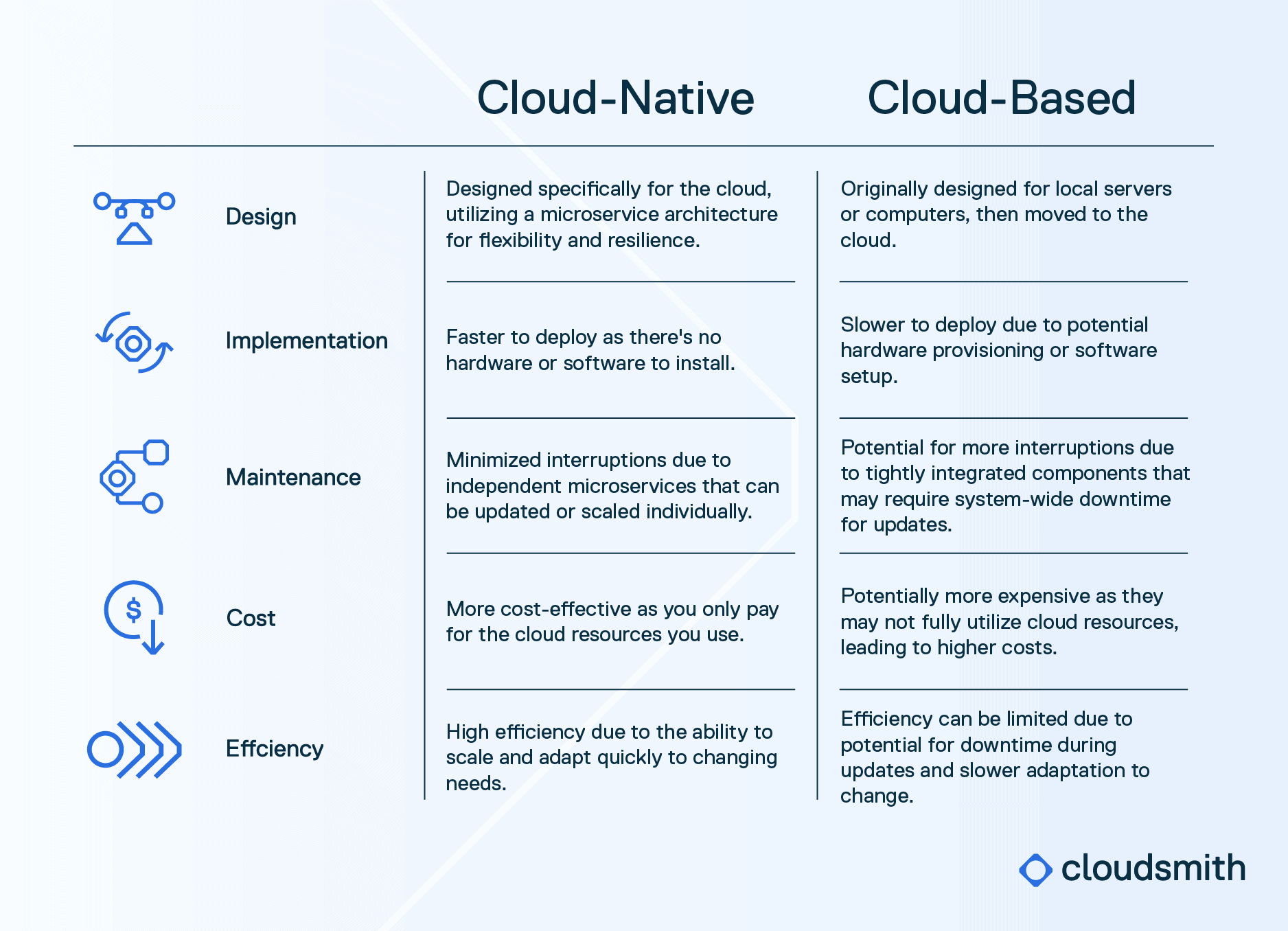Member post originally published on the Cloudsmith blog by Andrea Saez
Get to know the differences between cloud-native and cloud-based applications, their benefits, and why a cloud-native tool like Cloudsmith is a game-changer for efficient and secure software artifact management.
The term ‘cloud’ has become a buzzword in the tech industry, often used interchangeably to describe anything from online storage to complex computing services. But what does it really mean? And more importantly, what does it mean for your business?
“The Cloud” is a concept that has certainly revolutionized the way we store, manage, and interact with data. But as with any technological advancement, the cloud comes with its own set of terminologies that can often be confusing. Two such terms that often cause a mix-up are ‘cloud-native’ and ‘cloud-based’. While they might sound similar, they represent different approaches to using the cloud. Understanding these differences is crucial for businesses looking to leverage the power of the cloud effectively.
In this blog post, we’ll look at the differences between cloud-native and cloud-based applications, explore their pros and cons, and help you understand which approach might be the best fit for your business. We’ll also introduce you to Cloudsmith (that’s us!) a cloud-native tool that’s designed to streamline your software supply chain management, giving you complete control over how you distribute software.
Understanding Cloud Applications: A Tale of Two Clouds
Cloud-based applications are akin to a well-loved, well-used piece of furniture that you’ve decided to move into a new house. These applications were originally designed to run on local servers or personal computers but have been relocated to the cloud. While this move offers the benefits of the cloud, such as remote access and reduced physical infrastructure, it also brings along some of the old furniture’s quirks.
These applications are tightly integrated, meaning their components are interconnected and dependent on each other. This integration can be a strength, providing consistency and reliability. However, it also means that when one part of the application needs an upgrade or encounters an issue, the entire system might need to be taken offline. This can lead to downtime, which can disrupt operations and impact productivity.
In contrast, cloud-native applications are like a house built from scratch, designed to fit the specific characteristics of its location. These applications are designed specifically for the cloud environment from the get-go. They’re built to be flexible, scalable, and resilient, taking full advantage of the cloud’s capabilities.
Cloud-native applications often employ a microservice architecture. This means they’re composed of small, independent services that work together, much like a well-coordinated sports team. Each player (or service) has a specific role and can operate independently of the others. This independence means that individual parts of a cloud-native application can be updated, scaled, or even taken offline without disrupting the entire system.
Comparing Cloud-Native and Cloud-Based Applications
So what’s the difference? It comes down to it, it’s all about design, implementation, maintenance, and cost.
Cloud-native applications are faster to deploy because there’s no hardware or software to install. They’re designed to minimize interruptions, thanks to their microservice architecture. And because you’re only paying for the cloud resources you use, they can be more cost-effective.
Cloud-based applications, while still offering the benefits of the cloud, can be slower to deploy and more prone to interruptions. Because they weren’t originally designed for the cloud, they might not be able to take full advantage of all the cloud’s benefits.

The Benefits of Using a Cloud-Native Tool: Introducing Cloudsmith
Enter Cloudsmith, a cloud-native, fully managed, universal artifact management platform. Cloudsmith is designed to help you manage your software assets efficiently and securely, giving you complete control over your software supply chain.
But why is artifact management so important? In the world of software development, an artifact is any file or resource that is produced during the software development process. This could be anything from compiled source code and documentation to test data and final software packages. Managing these artifacts effectively is crucial for maintaining the efficiency, reliability, and security of your software supply chain. It allows you to keep track of the different versions of your software, ensure that your teams are always working with the correct resources, and protect your software from potential security threats.
Cloudsmith provides a centralized platform for managing and distributing software packages. It’s like having a dedicated, secure, and efficient delivery service for your software. You can track and control your software assets, ensuring they’re delivered quickly and securely. It is flexible, scalable, and resilient, and specifically built to minimize downtime and maximize efficiency.
And because Cloudsmith is cloud-native, it’s always evolving. It’s designed to adapt to the changing needs of your business and the wider software landscape. As a fully-managed platform, we worry about all the maintenance, while you focus on core development work. So as your business grows, Cloudsmith grows with you.
Conclusion
Choosing between cloud-native and cloud-based applications often comes down to your specific needs and circumstances. Both have their strengths and can offer significant benefits. However, cloud-native applications like Cloudsmith offer a level of flexibility, scalability, and resilience that’s hard to beat. They’re designed for the cloud, built to take full advantage of its capabilities, and ready to adapt to your organisation’s evolving needs.
If you’re looking for a tool that can help you manage your software supply chain efficiently and securely, don’t be shy about reaching out! After all, we were built by developers, for developers.